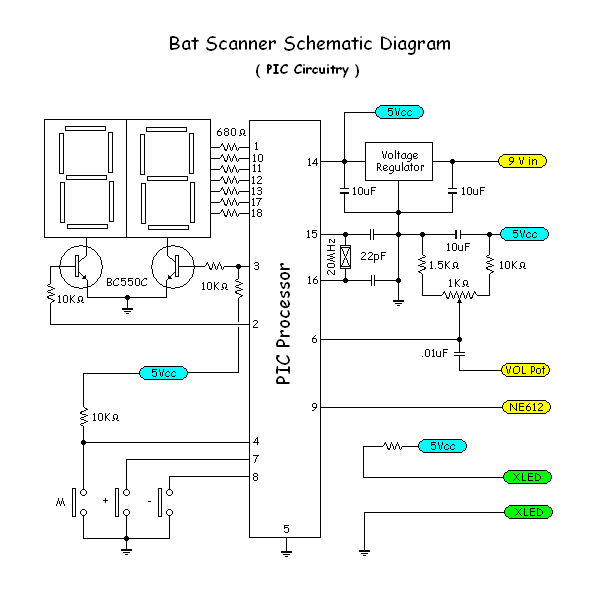The Digital "Bat Scanner"
Detector
.
The Bat Scanner's analog circuitry is based on a heterodyne bat detector circuit published by Bertrik Sikken some years ago. Over the years we have tweaked it a little to optimize it for our specific application.
The electret microphone is amplified by a two transistor preamp. The first transistor provides the bulk of the amplification, and selectively enhances the higher ultrasonic frequencies we are interested in. The second transistor buffers the signal and provides bi-phased ( push / pull ) drive signals for the SA612 mixer IC.
The SA612 mixer IC receives the ultrasound audio signals on pins 1 and 2. A mixer oscillator frequency ( from pin 9 of the PIC ) is picked up by pin 6 of the mixer IC and is mixed with the ultrasound audio signals. This generates a difference signal that essentially converts the ultrasound signal to the audio range. The audio signal is taken from pin 5 of the mixer IC , filtered, and fed to the volume control, and to pin 6 of the PIC. The output of the volume control goes to the input ( pin 3) of LM386 amplifier IC to drive the speaker.
More information about the SA612 and LM386 IC's can be found by downloading their datasheets:

The Bat Scanner's digital circuitry is centered around a 16F628A PIC processor. The processor provides a multiplexed frequency display using two BC550C transistor digit switches. A complex PWM routine constantly feeds the local oscillator frequency via pin 9 to the SA612 mixer. The bat call audio is sampled from the volume pot by coupling it to a biased digital input pin and detecting sound peaks. Meanwhile the three control push buttons are monitored by three more digital inputs. You can see that ALL the pins are put to good use.
For the purpose of programming a replacement PIC processor, to repair a BatScanner that has been built from a parts kit that Frank or I may have provided, here is a link to the HEX file for the firmware in the PIC.
The information on this page is provided to make it easier to understand how the Bat Scanner works, and to facilitate troubleshooting a detector that is not operating properly. The information is not meant to be a source reference for constructing a BatScanner.
Tony Messina - Las Vegas, Nevada - email: T-Rex@ix.netcom.com